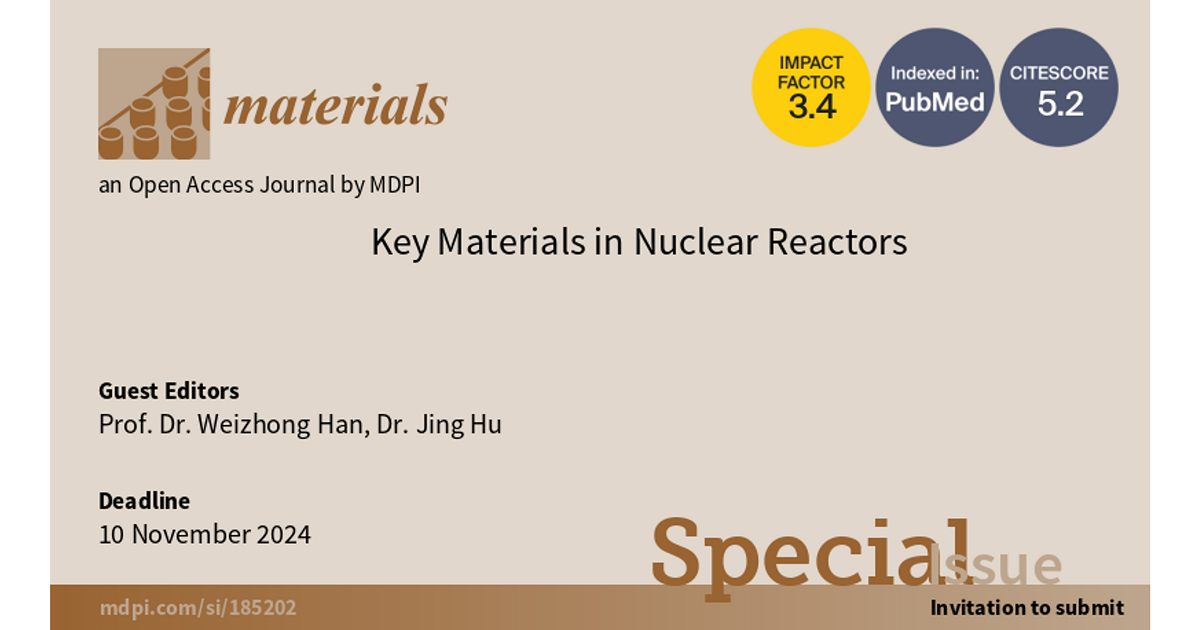Key Materials in Nuclear Reactors
A special issue of Materials (ISSN 1996-1944). This special issue belongs to the section "Materials Physics".
Deadline for manuscript submissions: 10 November 2024 | Viewed by 2140

Special Issue Editors
Interests: radiation damage; mechanical properties; zirconium; tungsten; interface engineering; dislocation
Special Issue Information
Dear Colleagues,
Nuclear power continues to play a significant role in providing clean, reliable, and sustainable energy. However, the operation of nuclear reactors poses unique challenges related to material performance, safety, and long-term sustainability. There is a growing need to explore new materials that can withstand extreme environments, exhibit enhanced resistance to radiation damage, offer improved corrosion resistance, and provide superior mechanical properties. These advancements can result in the enhanced efficiency, safety, and longevity of nuclear reactors, paving the way for the future of nuclear energy.
This Special Issue on key materials in nuclear reactors will provide a platform on which to share cutting-edge research, exchange ideas, and foster a multidisciplinary dialogue that can lead to breakthroughs in material development, characterization techniques, and applications in the nuclear industry.
We cordially invite you to contribute to the Special Issue by presenting your research papers on nuclear materials; the topics of interest include, but are not limited to the following:
- Nuclear reactor materials
- Nuclear fuel cycle and materials
- Radiation effects on materials
- Nuclear waste management and disposal
- Structural integrity and material performance
- Radiation shielding materials
- Nuclear material characterization techniques
- Materials for fusion reactors
Thank you for considering our invitation, and we look forward to welcoming you to this Special Issue on key materials in nuclear reactors.
Prof. Dr. Weizhong Han
Dr. Jing Hu
Guest Editors
Manuscript Submission Information
Manuscripts should be submitted online at www.mdpi.com by registering and logging in to this website. Once you are registered, click here to go to the submission form. Manuscripts can be submitted until the deadline. All submissions that pass pre-check are peer-reviewed. Accepted papers will be published continuously in the journal (as soon as accepted) and will be listed together on the special issue website. Research articles, review articles as well as short communications are invited. For planned papers, a title and short abstract (about 100 words) can be sent to the Editorial Office for announcement on this website.
Submitted manuscripts should not have been published previously, nor be under consideration for publication elsewhere (except conference proceedings papers). All manuscripts are thoroughly refereed through a single-blind peer-review process. A guide for authors and other relevant information for submission of manuscripts is available on the Instructions for Authors page. Materials is an international peer-reviewed open access semimonthly journal published by MDPI.
Please visit the Instructions for Authors page before submitting a manuscript. The Article Processing Charge (APC) for publication in this open access journal is 2600 CHF (Swiss Francs). Submitted papers should be well formatted and use good English. Authors may use MDPI's English editing service prior to publication or during author revisions.
Keywords
- nuclear materials
- radiation damage
- structural integrity
- corrosion and hydrogen pickup
- fuel assemblies
- core design







